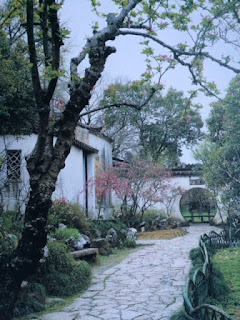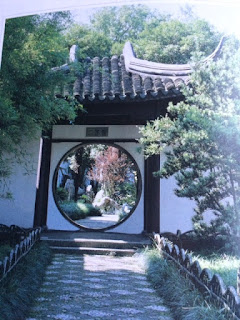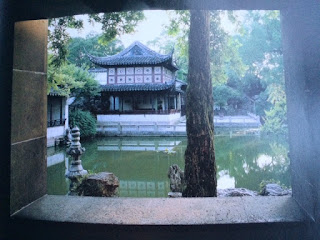Goodbye Rat. Hello Ox.
Happy Lunar New Year!
We are indeed saying goodbye to the year of the rat; ushering in the year of the ox.
Specifically, the year of the metal ox.
What does it mean?
According to experts, the metal ox can represent a range of metals ~ from jewelry to syringe needles. Soooo, I'm thinking we can best mark the Year of the Ox with a piece of jewelry (naturally!) perhaps in the form of a unique, hard-working, and versatile array of plant-styled arm cuffs or bracelets ~ because plants play such a key role in Lunar New Year festivities and I like these looks. I have some arm cuffs but don’t see them worn too much anymore. So, I’m thinking they will be good looking on all those Zoom calls where upper body looks are paramount. And the other metal ~ of course ~ the vaccine! Surely, that’s a sign of very good luck.
February 12 marks the start of the Lunar New Year. This is the Year of the Ox.
Asian countries, not just China, celebrate this gateway to spring.
From Korea to Malaysia to Japan to Indonesia, and our own city’s Chinatowns and Asian markets, Lunar New Year, or Tet, is celebrated with centuries-old traditions marked by food and flowers and plants. While the colorful street parades we all love will be tabled this year, you can enjoy the restaurants’ special foods. Frequent them. Order take out.
You can also visit the Museum of Chinese In America. The Museum offers a plethora of virtual programs ~ for the entire family.
It’s worth noting that the ox is a hardworking zodiac sign. Therefore, no rest for the home-bound workers nor the front line health-care or essential workers.
Rather than be disheartened or woebegone about the prospect of more work, Let’s be grateful for the opportunity to work at all.
In addition, I believe “Work” takes many forms. We can work to seek new ventures (open up that business that maybe has been a side hustle); to work to improve our community ~ volunteer where needed. We can work on ourselves to improve our character, our health (mental and physical) and work to improve our garden soil, plants and the environment…
I’ve learned that the Year of the Ox is a lucky sign that will focus us on relationships. I’m going to extrapolate that to lean into building better relationships in a post-covid world that embraces our work, family, friends, community and loved ones. Including our pets and our gardens…
So, Cheers ~ Ganbei (sounds like: “gon bay”).
And to toast to the year of the ox, here’s a perfect drink for your Lunar New Years’ celebrations ~ and I hope you have many over the 15-day festival ~ from my from from my Art of the Garnish book.
Courtesy of Jordan Bushnell, national brand ambassador for Hennessy.
As told in the Garnish book, This is a fiery red drink, its star anise and cocktail cherry garnish is sure to spice up your fortune…. “The drink was created for Chinese New Year so all the elements you see in the background are themed for good luck in the culture,” noted Jordan.
Ingredients:
¾ oz. fresh lemon juice
¾ oz. simple syrup
¼ teaspoon Chinese five-spice powder
5 dashes of Peychaud’s Bitters
Method:
Combine all ingredients in a cocktail shaker filled with ice, shake until chilled, and strain into an Old Fashioned glass containing fresh ice.
Finishing Touches:
Garnish with star anise and a maraschino cherry.
Thank you so much Jordan for this exquisite drink recipe, plus all your other spectacular contributions.
Back Story to the Lunar New Year Festival:
Lunar New Year is also known as the Spring Festival. Originally the purpose was to scare off Nian ~ the name means “new year” is a beast that lives under the sea or in the mountains (I think nian represents a kind of winter). Folks wanted to prevent Nian from returning, and created holiday decorations that are typically a bright and loud red to scare off the beast.
The color red is now a much loved color; representing happiness and good fortune.
Plants
Plants are an integral part of the Lunar New Year celebrations.
Many Asian families love flamingo flowers (Anthurium, a house plant in colder zones) for its auspicious red color, which symbolize good luck and prosperity. Meanwhile, as the shape of blossoms looks like hearts, which can also work for Valentine’s Day. The flowers also indicate happiness and enthusiasm and not just for their beauty; they are some of the longest-lasting blooms. (Some folks refer to the plant as the Little Boy flower for the, ahem, suggestive structure of the spadix. Smile) Everyone can love the plant as it’s super easy to take care of.
Orchids may be the most popular - they symbolize elegance, wealth, fertility and abundance.
Orchids bring good fortune. I’d like to believe that too. These exotic blooms surely bring me happiness.
Ahhhh, then there is my all-time favorite, the peony.
As the national flower of China, peonies are always popular in the flower markets. In Chinese mythology, peonies are always associated with richness, peace, honor and prosperity. As peonies are well-known as wealth flowers, they are great, especially red ones.
Last year, I splurged and got three tree peonies for my own garden. To amplify or complement my many
Narcissus, or water fairy flowers, symbolize wealth, prosperity and good luck, which will be perfect for you if you’re looking for lucky Chinese New Year flowers.
The sweet scent, bright color and delicate petals make narcissus quite popular among Chinese people.
Pussy willows, known as silver willow in China, symbolize prosperous wealth, and just like here, the coming of spring. As the branches of pussy willows usually come in tall height, they are related to growth and prosperity. Meanwhile, the furry blossoms are associated with abundance of fortune.
Fruit, fruit plants and cut fruit stems are equally important in Lunar New Year traditions
I grow lemon trees indoors all-year long. I adore the fragrance and the leaves. The fruit is almost a lucky-extra. I’ve got several ready for picking shortly. Usually, their harvest coincides with a favorite niece, Lauren and her husband’s visit to our homestead. So BC (before covid,) Lauren would pick a lemon for our martinis! So don’t be shy, citrus is easy and fun to grow.
In China, the peach fruit represents longevity while peach blossom symbolizes growth, prosperity and romance. As a result, peach blossoms are considered sacred. In my little orchard, too! With bright color and beautiful appearance, peach blossoms are quite popular during Lunar New Year. Look for them in your local flower market.
Peach blossoms are very popular among young people because they believe that peach blossoms will ignite romantic luck for those who are single. Leading into that Valentine’s Day…
Plum blossoms are another symbolic flower, indicating courage, perseverance and reliability. As the blossom season is around the same time as the Spring Festival, it’s a great idea to buy some plum blossoms to decorate your home. According to tradition, plum blossoms will attract long-term good fortune. I’m thinking it’s a good idea to put some plum blossoms in a pretty vase in your home office and bedroom…
Kumquats are a golden, festive color that represents wealth and fortune.
Add to that the fruit’s delicious flavor on its own and in various desserts, and it’s not a surprise why not only the cut flowers but having a small tree as an indoor, pretty, and fragrant plant is becoming so popular.
Kumquats are thought to bring auspicious meanings of wealth and good luck.
It’s also believed that the emerald green leaves will attract wealth, luck, and prosperity, as the leaves look like jade stone.
Mandarin oranges are also a great plant to grow and bring good luck. I have grown one for years in my home spa.
Chrysanthemum flowers are a long-time favored flower for bringing good fortune. (There is an autumn festival in Japan: Kiku, dedicated to the national flower.)
I just loved this cute image of puppies fashioned from mums!)
Where, you might ask, is the best place to purchase plants?
THE best place - for Lunar New Year plants ~ or anytime ~ is KinKa.
My esteemed friends, EunYoung and Tom, are the wonderful couple ~ both of whom are talented artists ~ who lovingly curate and run the shop. How adorable are these two?! I am so encouraging fine-artist Tom to create a children’s picture book. I love his sweet illustrations. Don’t you agree??
(KinKa fronts the excellent restaurant Maki Kosaka created by the award-winning, and Michelin-starred omakase KOSAKA restaurant owners. You must experience its incredible seafood, sushi, seasonal vegetables and elegant decor.)
KinKa is the “forbidden flowers” of the tea ceremony (wink) but you can readily get flowers and gifts here.
Who wouldn’t love these heart Hoyas as a gift?
The bouquets are heart-breakingly, tenderly, beautiful..
More beautiful floral compositions. See the web site for delivery and shipping.
| A Love Note card: KinKa |
Decor & Style
The Spring Festival Lunar New Year celebrations culminate in the Lantern launch after the 15 day celebration, this year on February 26th. That date is often referred to now as a Lunar New Year Valentine's day because young women could go out to view and admire the lanterns and, ahem, meet boys. (or those they are attracted to….) People write their poetry; most often their wishes, on the lanterns, then release them to the heavens in the hopes that their dreams will come true in the new year. Plus it’s so very cosmically beautiful. You could recreate this at home if you live in a place with a big enough yard.
Red Pocket Lucky Money
I use these red envelopes as part of my Lunar New Year tablescape. I would go to Chinatown every year and get that year’s red envelopes and gift to our dinner party and Ladies Who Lunch guests - for good luck. It's said that the money “anchors the year.”
The red, lucky money envelope tradition started as protection against Nian. Parents would give children money on the first night of Lunar New Year. This way, the children would have something to bribe the monster or other evil spirits with.
Food
I’ll single out a delightful cookbook here for you that was recently sent to me for review: Real Vietnamese Cooking, Everyday Favorites from the Street to the Kitchen.
As the overview proclaims, the cookbook combines the “collective culinary wisdom of three intrepid food explorers” Yumiko Adachi, Shinobu Ito, and Masumi Suzuki, who trained with some of Vietnam's best chefs while eating their way through the country’s city streets and “country kitchens in search of tastes” and treats. The 88 recipes are arranged in a terrific presentation including: from the history or origins of Vietnamese cuisine, a presentation of Vietnamese seasonings,
Herbs and Aromatics, Seasonings, followed by the Basic Recipes.
There is an interesting background that explains what the Vietnamese eat for their three daily meals, in addition to Snacks and Feasts ~ and lots of Street Food!
I find the full-color photographs so helpful. And fun to view. It’s like you are there with the author/cooks as they guide you step-by-step.
The images very much illustrate the ingredients, the step-by-step preparations, and the finished dishes.
The recipes are grouped into categories: mainly Rice Dishes ~ (paper, rice flour, and noodles), Bánh MÌ sandwiches, Pub Food and Bar Snacks, Salads and Vegetables, Vietnamese Hot Pots (love these), Snacks, Desserts, and Drinks.
I should point out that while the dishes look exotic, the ingredients are all readily available at your local markets.
I very much look forward to making my favorite food and drink recipes: Fresh Spring Rolls, Hot Pots, Firecracker Shrimp, and the Coconut Coffee Milkshake!
Here’s a recent Lunar New Year menu that is worth repeating. I mixed Asian and Peruvian and Mediterrean dishes! Hey, we’re a melting pot!
A fun food serving presentation is to place an amuse bouche or finger food in a music box.
When you’re guests and loved ones open up the box at their plate, not only is the pretty box and music waft out to greet them, but the surprise of finding a treat is pure joy!
 |
| Miso Soup ~ Our remix, photo: Angie Lambert |
Valentine & Lunar New Year Celebration 2018
Hosted by: Duchess Designs
Pink Champagne
Alfajores Cookie Baking with Marita Lynn
Dumplings in Music Box
Miso Soup with Carrots
Beet Burger Heart Salad
Heart Cheese Ravioli with Shrimp Marinara Sauce
Pink Raspberry Panna Cotta
Chocolate Fondue with Citrus, Banana, Strawberry, Marshmallow
Bourbon/or Mocktail Milkshake
Shrub Mocktail
Coffee, Tea
Alfajores Recipe - Marita Lynn
Yield: 50 alfajores
2 cups all purpose flour, sifted
¾ cup butter, room temperature
4 tablespoons powdered sugar
1 cup dulce de leche
Preparation:
In a bowl, mix together, the flour, butter and sugar. Once mixed, use your hands to create a uniform dough. Cover the dough with plastic wrap and rest in the refrigerator for 30 minutes.
Heat the oven to 350 degrees.
On a floured surface, making sure to flour your roller, roll the dough to ½- inch thickness.
Using a 2 inch round cutter, cut out alfajores and place on baking sheet.
Bake for 20 minutes, let the alfajores cool on a wire rack.
Filled the alfajores with dulce de leche sandwich style.
Dust with powdered sugar.
*Dulce de leche can be bought at any store, jarred or in a can
* @KitchenIntuitionByMaritaLynn
Good luck to you and your loved ones for a prosperous, lucky, 2021.



























